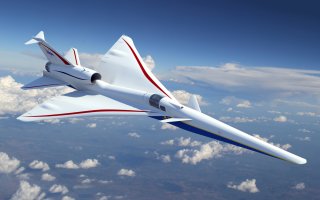Lockheed Martin’s Supersonic X-59 Could Transform Everything
The company has built a pretty strange-looking plane.
Here's What You Need to Know: A new supersonic technology demonstrator might revolutionize air travel.
Commercial travel at supersonic speeds has been something of a wild goose chase. There are a number of technically challenging engineering obstacles that have to be overcome in order for a supersonic jet airliner to be both just possible—and importantly, commercially viable. Though difficult, there have been several supersonic jet airliners built, though they enjoyed varying degrees of success.
Back in the U.S.S.R.
The Soviet Union was the first in the supersonic airliner field. Beginning with their Tu-144 jet, built by the venerable Tupolev design bureau, the Soviets owned the skies—for a very short time. The Tu-144 was based on the Anglo-French developed Concorde jet, as evidenced by their strikingly similar geometry.
Though first, the Tu-144 was not the best. It suffered from high weight, thanks in part to a larger landing gear design. It further suffered from high fuel consumption due to the high-output jet engines it needed to keep it airborne. The Tu-144 flew just a paltry 102 commercial flights, only about half of which carried any passengers—making it a commercial failure. The rival it was modeled on, the Concorde, was considerably more successful.
Anglo-French Cooperation
The European venture into the supersonic airline industry was the pride of the French and the Brits. They couldn’t match the United States’ nor the Soviet Union’s space programs—but they could build a supersonic passenger jet. So they did.
The Concorde flew for about a quarter of a century, not exactly a star compared to other commercial jet designs like the 474, but it was at the top of the supersonic pack. It was lighter, and somewhat smaller than the Soviet copycat. It offered quick service between western Europe and the East Coast, though exclusively for the luxury air travel crowd.
One of the Concorde’s drawbacks, like the Tu-144, was its loud sonic boom. To reduce disturbances to residents on the ground, the Concorde’s throttle was restricted over land, taking advantage of its supersonic top speed only over the ocean. This obviously hampered its utility.
The Americans Return
Like their Soviet rivals, the United States’ original foray into supersonic air transport was a disaster—worse even than the Soviets. The American jet didn’t make it past the mockup stage, as testing in the mid-1960s revealed that public opinion was deeply opposed to sonic booms, which were jarring to residents. For this reason, the American supersonic project was abandoned. It has recently made a comeback, however.
NASA is back in the supersonic passenger jet game. In tandem with Lockheed Martin’s Skunk Works division, research is being done into lowering sonic boom decibel levels. The test airframe, the X-59 Quiet SuperSonic Technology jet is “on a mission to achieve supersonic speeds over land that create no more than a sonic “thump” to those below.”
An X-59 project manager described the project’s ultimate goal, “The X-59 is designed so that, as it flies faster than sound, any sonic booms that reach the ground are so quiet they can barely be heard—if at all.”
In order to achieve this goal, NASA and Lockheed Martin built a pretty strange-looking plane. Its cruising speed will be around Mach 1.4, and is estimated to produce a mere 75 decibels or sound, roughly comparable to a home vacuum cleaner.
This optimistic sound estimate is hope to be achieved thorough the X-59’s long and narrow fuselage, and two forward canard wings, which are designed to prevent or disperse shock waves that cause a sonic boom. Initial flight tests are scheduled for sometime in 2021. Is this the future of commercial aviation?
Caleb Larson holds a Master of Public Policy degree from the Willy Brandt School of Public Policy. He lives in Berlin and writes on U.S. and Russian foreign and defense policy, German politics, and culture.
This article first appeared in June 2020.
Image: NASA / Lockheed Martin

